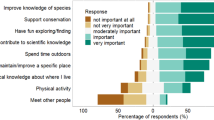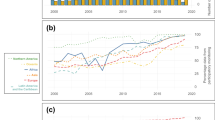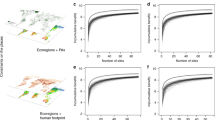Abstract
Inadequate information on the geographical distribution of biodiversity hampers decision-making for conservation. Major efforts are underway to fill knowledge gaps, but there are increasing concerns that publishing the locations of species is dangerous, particularly for species at risk of exploitation. While we recognize that well-informed control of location data for highly sensitive taxa is necessary to avoid risks, such as poaching or habitat disturbance by recreational visitors, we argue that ignoring the benefits of sharing biodiversity data could unnecessarily obstruct conservation efforts for species and locations with low risks of exploitation. We provide a decision tree protocol for scientists that systematically considers both the risks of exploitation and potential benefits of increased conservation activities. Our protocol helps scientists assess the impacts of publishing biodiversity data and aims to enhance conservation opportunities, promote community engagement and reduce duplication of survey efforts.
This is a preview of subscription content, access via your institution
Access options
Access Nature and 54 other Nature Portfolio journals
Get Nature+, our best-value online-access subscription
$29.99 / 30 days
cancel any time
Subscribe to this journal
Receive 12 digital issues and online access to articles
$119.00 per year
only $9.92 per issue
Buy this article
- Purchase on Springer Link
- Instant access to full article PDF
Prices may be subject to local taxes which are calculated during checkout

Similar content being viewed by others
References
Costello, M. J., May, R. M. & Stork, N. E. Can we name Earth’s species before they go extinct? Science 339, 413–416 (2013).
Boitani, L. et al. What spatial data do we need to develop global mammal conservation strategies?. Phil. Trans. R. Soc. B 366, 2623 (2011).
Rondinini, C., Wilson, K. A., Boitani, L., Grantham, H. & Possingham, H. P. Tradeoffs of different types of species occurrence data for use in systematic conservation planning. Ecol. Lett. 9, 1136–1145 (2006).
Whittaker, R. J. et al. Conservation biogeography: assessment and prospect. Divers. Distrib. 11, 3–23 (2005).
Winter, M. et al. Patterns and biases in climate change research on amphibians and reptiles: a systematic review. R. Soc. Open Sci. 3, 160158 (2016).
Feeley, K. J. & Silman, M. R. Keep collecting: accurate species distribution modelling requires more collections than previously thought. Divers. Distrib. 17, 1132–1140 (2011).
Joppa, L. N. et al. Filling in biodiversity threat gaps. Science 352, 416–418 (2016).
Zeller, D., Froese, R. & Pauly, D. On losing and recovering fisheries and marine science data. Mar. Policy 29, 69–73 (2005).
Walsh, J. C., Dicks, L. V. & Sutherland, W. J. The effect of scientific evidence on conservation practitioners’ management decisions. Conserv. Biol. 29, 88–98 (2015).
Turner, D. J., Smyth, A. K., Walker, C. M. & Lowe, A. J. in Terrestrial Ecosystem Research Infrastructures (eds Chabbi, A. & Loescher, H. W.) 341–368 (CRC Press, London, 2017).
Sullivan, B. L. et al. eBird: a citizen-based bird observation network in the biological sciences. Biol. Conserv. 142, 2282–2292 (2009).
Rausher, M. D., McPeek, M. A., Moore, A. J., Rieseberg, L. & Whitlock, M. C. Data archiving. Evolution 64, 603–604 (2010).
Whitlock, M. C., McPeek, M. A., Rausher, M. D., Rieseberg, L. & Moore, A. J. Data archiving. Am. Nat. 175, 145–146 (2010).
Fuller, R. A., Lee, J. R. & Watson, J. E. M. Achieving open access to conservation science. Conserv. Biol. 28, 1550–1557 (2014).
Ngo, H. et al. First population assessment of two cryptic tiger geckos (Goniurosaurus) from northern Vietnam: implications for conservation. Amphib. Reptile Conserv. 10, 34–45 (2016).
Lindenmayer, D. & Scheele, B. Do not publish. Science 356, 800–801 (2017).
Runge, C. A., Tulloch, A., Hammill, E., Possingham, H. P. & Fuller, R. A. Geographic range size and extinction risk assessment in nomadic species. Conserv. Biol. 29, 865–876 (2015).
Herzog, S. K., Maillard, Z. O., Embert, D., Caballero, P. & Quiroga, D. Range size estimates of Bolivian endemic bird species revisited: the importance of environmental data and national expert knowledge. J. Ornithol. 153, 1189–1202 (2012).
Chapman, A. D. & Grafton, O. Guide to Best Practices for Generalising Sensitive Species Occurrence Data (Global Biodiversity Information Facility, Copenhagen, 2008).
Alonso, L. E., Deichmann, J. L., McKenna, S. A., Naskrecki, P. & Richards, S. J. Still Counting...Biodiversity Exploration for Conservation. The First 20 Years of the Rapid Assessment Program (Univ. Chicago Press, Chicago, 2011).
Reichman, O. J., Jones, M. B. & Schildhauer, M. P. Challenges and opportunities of open data in ecology. Science 331, 703–705 (2011).
Wallis, J. C., Rolando, E. & Borgman, C. L. If we share data, will anyone use them? Data sharing and reuse in the long tail of science and technology. PLoS ONE 8, e67332 (2013).
Borgman, C. L. The conundrum of sharing research data. J. Am. Soc. Inf. Sci. Tec. 63, 1059–1078 (2012).
McKiernan, E. C. et al. The open research value proposition: how sharing data can help researchers succeed. figshare https://doi.org/10.6084/m9.figshare.1619902.v2 (2016).
Borgman, C. L. et al. Knowledge infrastructures in science: data, diversity, and digital libraries. Int. J. Digit. Libr. 16, 207–227 (2015).
Johnson, T. R. & van Densen, W. L. T. Benefits and organization of cooperative research for fisheries management. ICES J. Mar. Sci. 64, 834–840 (2007).
Maxwell, S. L., Fuller, R. A., Brooks, T. M. & Watson, J. E. Biodiversity: the ravages of guns, nets and bulldozers. Nature 536, 143–145 (2016).
Fisher, D. O. Trajectories from extinction: where are missing mammals rediscovered? Glob. Ecol. Biogeogr. 20, 415–425 (2011).
Fisher, D. O. & Blomberg, S. P. Correlates of rediscovery and the detectability of extinction in mammals. Proc. R. Soc. B 278, 1090–1097 (2011).
Kissling, W. D. et al. Building essential biodiversity variables (EBVs) of species distribution and abundance at a global scale. Biol. Rev. 93, 600–625 (2018).
Proença, V. et al. Global biodiversity monitoring: from data sources to essential biodiversity variables. Biol. Conserv. 213, 256–263 (2017).
Trindade-Filho, J., de Carvalho, R. A., Brito, D. & Loyola, R. D. How does the inclusion of Data Deficient species change conservation priorities for amphibians in the Atlantic Forest? Biodivers. Conserv. 21, 2709–2718 (2012).
Setiawan, R. et al. Preventing global extinction of the Javan rhino: tsunami risk and future conservation direction. Conserv. Lett. 11, e12366 (2018).
Leader-Williams, N., Baldus, R. D. & Smith, R. J. in Recreational Hunting, Conservation and Rural Livelihoods: Science and Practice (eds Dickson, B., Hutton, J. & Adams, W. A.) 296–316 (Wiley-Blackwell, Oxford, 2009).
Loveridge, A. J., Hemson, G., Davidson, Z. & Macdonald, D. W. in Biology and Conservation of Wild Felids (eds Macdonald, D. W. & Loveridge, A. J.) 283–304 (Oxford Univ. Press, Oxford, 2010).
Steven, R., Pickering, C. & Guy Castley, J. A review of the impacts of nature based recreation on birds. J. Environ. Manag. 92, 2287–2294 (2011).
Gonzalez, J. A. Effects of harvesting of waterbirds and their eggs by native people in the northeastern Peruvian Amazon. Waterbirds 22, 217–224 (1999).
Arlettaz, R. et al. From publications to public actions: when conservation biologists bridge the gap between research and implementation. Bioscience 60, 835–842 (2010).
Burgman, M. A. Risks and Decisions for Conservation and Environmental Management (Cambridge Univ. Press, New York, 2005).
Kelly, C. L., Pickering, C. M. & Buckley, R. C. Impacts of tourism on threatened plant taxa and communities in Australia. Ecol. Manag. Restor. 4, 37–44 (2003).
Ballantyne, M. & Pickering, C. Ecotourism as a threatening process for wild orchids. J. Ecotourism 11, 34–47 (2012).
Hissmann, K. et al. The South African coelacanths - an account of what is known after three submersible expeditions: coelacanth research. S. Afr. J. Sci. 102, 491–500 (2006).
Erdmann, M. Lessons learned from the conservation campaign for the Indonesian coelacanth, Latimeria menadoensis: coelacanth research. S. Afr. J. Sci. 102, 501–504 (2006).
Tulloch, V. J. D. et al. Why do we map threats? Linking threat mapping with actions to make better conservation decisions. Front. Ecol. Environ. 13, 91–99 (2015).
IUCN Red List of Threatened Species. Version 2017-3 (IUCN, Gland, accessed 5 January 2018); http://www.iucnredlist.org
Michener, W. K. Ecological data sharing. Ecol. Inform. 29, 33–44 (2015).
Smith, M., Szongott, C., Henne, B. & Von Voigt, G. Big data privacy issues in public social media. In 2012 6th IEEE International Conference on Digital Ecosystems Technologies (DEST) 1–6 (IEEE, 2012).
Mancini, A. & Koch, V. Sea turtle consumption and black market trade in Baja California Sur, Mexico. Endanger. Species Res. 7, 1–10 (2009).
Barry, C. Australia’s wildlife blackmarket trade. Australian Geographic (16 August 2011); http://www.australiangeographic.com.au/topics/wildlife/2011/08/australias-wildlife-blackmarket-trade/
Stiles, D., Redmond, I., Cress, D., Nellemann, C. & Formo, R. K. Stolen Apes: The Illicit Trade in Chimpanzees, Gorillas, Bonobos and Orangutans A Rapid Response Assessment (United Nations Environment Programme, GRID-Arendal, Arendal, 2013).
Auliya, M. et al. Trade in live reptiles, its impact on wild populations, and the role of the European market. Biol. Conserv. 204A, 103–119 (2016).
Collins-Kreiner, N., Malkinson, D., Labinger, Z. & Shtainvarz, R. Are birders good for birds? Bird conservation through tourism management in the Hula Valley, Israel. Tour. Manag. 38, 31–42 (2013).
Lowe, A. J. et al. Publish openly but responsibly. Science 357, 141–141 (2017).
Michener, W. K., Brunt, J. W., Helly, J. J., Kirchner, T. B. & Stafford, S. G. Nongeospatial metadata for the ecological sciences. Ecol. Appl. 7, 330–342 (1997).
Piwowar, H. A., Day, R. S. & Fridsma, D. B. Sharing detailed research data is associated with increased citation rate. PLoS ONE 2, e308 (2007).
Campbell, E. G. & Bendavid, E. Data-sharing and data-withholding in genetics and the life sciences: results of a national survey of technology transfer officers. J. Health Care Law Policy 6, 241–255 (2003).
Tenopir, C. et al. Data sharing by scientists: practices and perceptions. PLoS ONE 6, e21101 (2011).
Keniger, L., Gaston, K., Irvine, K. & Fuller, R. What are the benefits of interacting with nature? Int. J. Env. Res. Pub. Health 10, 913 (2013).
Rosen, G. E. & Smith, K. F. Summarizing the evidence on the international trade in illegal wildlife. EcoHealth 7, 24–32 (2010).
Boakye, M. K., Pietersen, D. W., Kotzé, A., Dalton, D.-L. & Jansen, R. Knowledge and uses of African pangolins as a source of traditional medicine in Ghana. PLoS ONE 10, e0117199 (2015).
Gong, S.-P., Chow, A. T., Fong, J. J. & Shi, H.-T. The chelonian trade in the largest pet market in China: scale, scope and impact on turtle conservation. Oryx 43, 213–216 (2009).
Stuart, B. L., Rhodin, A. G. J., Grismer, L. L. & Hansel, T. Scientific description can imperil species. Science 312, 1137–1137 (2006).
Purcell, S. W. et al. Sea cucumber fisheries: global analysis of stocks, management measures and drivers of overfishing. Fish Fish. 14, 34–59 (2013).
Packer, C. et al. Effects of trophy hunting on lion and leopard populations in Tanzania. Conserv. Biol. 25, 142–153 (2011).
Meeuwig, J. J., Harcourt, R. G. & Whoriskey, F. G. When science places threatened species at risk. Conserv. Lett. 8, 151–152 (2015).
Crawford, A. & Bernstein, J. MEAs, Conservation and Conflicts: A Case Study of Virunga National Park, DRC (International Institute for Sustainable Development, Geneva, 2008).
Jenkins, M. Who murdered the Virunga gorillas?. Natl Geogr. 214, 34–65 (2008).
Sattler, P. & Williams, R. The Conservation Status of Queensland’s Bioregional Ecosystems (QLD Environment Protection Agency, Brisbane, 1999).
Kearney, M. R., Porter, W. P. & Murphy, S. A. An estimate of the water budget for the endangered night parrot of Australia under recent and future climates. Clim. Change Responses 3, 14 (2016).
Murphy, S. A., Silcock, J., Murphy, R., Reid, J. & Austin, J. J. Movements and habitat use of the night parrot Pezoporus occidentalis in south-western Queensland. Austral Ecol. 42, 858–868 (2017).
Sadovy de Mitcheson, Y. et al. Fishing groupers towards extinction: a global assessment of threats and extinction risks in a billion dollar fishery. Fish Fish. 14, 119–136 (2013).
Jumin, R. et al. From Marxan to management: ocean zoning with stakeholders for Tun Mustapha Park in Sabah, Malaysia. Oryx 1–12 (2017).
Adams, V. M., Tulloch, V. J. & Possingham, H. P. Land-Sea Conservation Assessment for Papua New Guinea: A Report on the Work Undertaken to Fulfil the Terms of the Project Review and Integration of the Terrestrial and Marine Program of Works on Protected Areas (University of Queensland, and Conservation and Environment Protection Authority, 2016).
Government of Papua New Guinea National Marine Conservation Assessment for Papua New Guinea (Conservation and Environment Protection Authority, 2015).
Hamilton, R., Sadovy de Mitcheson, Y. & Aguilar-Perera, A. in Reef Fish Spawning Aggregations: Biology, Research and Management (eds Sadovy de Mitcheson, Y. & Colin, P.) 331–369 (Fish & Fisheries Series Vol. 35, Springer, Dordrecht, 2012).
Lavery, T. H. & Judge, H. A new species of giant rat (Muridae, Uromys) from Vangunu, Solomon Islands. J. Mammal. 98, 1518–1530 (2017).
Barcelona, J. F., Pelser, P. B., Balete, D. S. & Co, L. L. Taxonomy, ecology, and conservation status of Philippine Rafflesia (Rafflesiaceae). Blumea 54, 77–93 (2009).
Olson, R. J. & McCord, R. A. in Ecological Data: Design, Management, and Processing (eds Michener, W. K. & Brunt, J. W.) 117–141 (Blackwell Science, Oxford, 2000).
Acknowledgements
A.I.T.T. was supported by an Australian Research Council Discovery Early Career Researcher Award DE170100599. E.B., G.E., N.P.L. and L.R. were supported by the Australian Government National Environmental Science Programme’s Threatened Species Recovery Hub. N.P.L. was partially funded by Bush Heritage Australia. N.B. was supported by an Australian Research Council DECRA DE150101552. TERN (A.K.S.) is supported by the Australian National Collaborative Research Infrastructure Strategy. R. Alcorn (eBird), T. Laity (Australian Government Department of the Environment and Energy), S. Murphy and A. Kutt (Bush Heritage Australia) provided feedback on early drafts. J. Miller and R. Fuller contributed to early discussions.
Author information
Authors and Affiliations
Contributions
A.I.T.T. led the development of the risk assessment and decision tree with contributions from all authors to the final decision protocol. All authors provided ideas and critical feedback, and co-wrote the manuscript.
Corresponding author
Ethics declarations
Competing interests
The authors declare no competing interests.
Additional information
Publisher’s note: Springer Nature remains neutral with regard to jurisdictional claims in published maps and institutional affiliations.
Supplementary information
Supplementary Information
Supplementary Information; Supplementary Tables 1-2; Supplementary Figure 1; Supplementary References
Rights and permissions
About this article
Cite this article
Tulloch, A.I.T., Auerbach, N., Avery-Gomm, S. et al. A decision tree for assessing the risks and benefits of publishing biodiversity data. Nat Ecol Evol 2, 1209–1217 (2018). https://doi.org/10.1038/s41559-018-0608-1
Received:
Accepted:
Published:
Issue Date:
DOI: https://doi.org/10.1038/s41559-018-0608-1
This article is cited by
-
Does scientific interest in the nature impacts of food align with consumer information-seeking behavior?
Sustainability Science (2021)
-
Photographic database of the European cave salamanders, genus Hydromantes
Scientific Data (2020)
-
Decision trees for data publishing may exacerbate conservation conflict
Nature Ecology & Evolution (2019)
-
Consider species specialism when publishing datasets
Nature Ecology & Evolution (2019)
-
Opinions of citizen scientists on open access to UK butterfly and moth occurrence data
Biodiversity and Conservation (2019)



